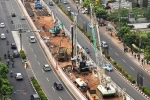East-West MRT project accelerated
This article has been translated by PwC Indonesia as part of our Indonesia Infrastructure News Service. PwC Indonesia has not checked the accuracy of, and accepts no responsibility for the content.
Investor Daily - Proyek MRT East-West dikebut
24 January 2023
By: Amrozi Amenan
Jakarta - The government is continuously accelerating the East-West Line Mass Rapid Transit (MRT) project. This project is the development of MRT Phase 3 worth Rp160 trillion. The route is Balaraja-Cikarang spanning 84.10 kilometres (km).
“The President directed the project to be completed or achieve financial close in 2024, so this program needs to be followed up,” Coordinating Minister for Economic Affairs Airlangga Hartarto said as the Committee for Acceleration of Priority Infrastructure (KPPIP) Chairperson in his official statement as quoted on Monday (23/1/2023). Airlangga said that the construction of East-West MRT was in line with the government’s effort to reduce reliance on fuel consumption and traffic congestion that is a large problem for Greater Jakarta. The government is also planning to provide three operational depots for East-West MRT that is estimated to carry 1.2 million passengers per day. East-West MRT will cover 49 transit-oriented development (TOD) areas.
“So, it will provide a solution for public transportation on a massive scale,” Airlangga said.
Furthermore, Airlangga revealed that the completion of East-West MRT was the development of MRT Phase 3 with the route spanning 84,102 km from Balaraja to Cikarang. With financial support from Japan as the main investor, the project worth Rp160 trillion is divided into two phases, namely phase 1 that includes Jakarta and phase 2 that includes Banten and West Java.
Phase 1 will be divided again into stage 1 that spans 24.53 km that will go through Tomang, Dukuh Atas, Senen, Perintis, and Medan Satria. Meanwhile, stage 2 spans 9.24 km and will go through Tomang and Kembangan. East-West MRT phase 1 is expected to operate in 2031, and its construction is set to be completed in 2024 at the latest.
Meanwhile, East-West MRT phase 2 will be divided into East-West Banten spanning 29.90 km that will go through Kembangan, Kelapa Dua, to Balaraja and East-West West Java spanning 20.44 km that will go through Medan Satria and Cikarang. “Phase 2 is expected to operate in 2033,” Airlangga said.
Airlangga affirmed that infrastructure advancement in various regions was the commitment of the government, and it is implemented by accelerating the completion of several national strategic projects (PSNs). PSN construction acceleration is expected to give a multiplier effect socially and economically to benefit the people.
He said that Jakarta has 27 PSNs with an estimated investment value of Rp313 trillion, based on the evaluation in January 2023. “Out of the 27 projects, three PSN are operational, four are partly operational, six are in construction, and 14 are in preparation or the transaction [stage],” he said. Previously, Transportation Minister Budi Karya Sumadi said that the East-West MRT project was still in the feasibility study process. He hopes that the project can commence in 2024. He also mentioned that there were currently two countries, namely Japan and the UK, that will invest in one of the PSNs.
Meanwhile, PT MRT Jakarta (Perseroda) has served more than 19.7 million passengers. That number shows that an average of 50 thousand people per day use Jakarta MRT with trips reaching 87,072.
PT MRT Jakarta Corporate Secretary Ahmad Pratomo explained that the passenger realisation surpassed the passenger target last year that reached 14.6 million people or an average of 40 thousand people per day.
“The punctuality of Ratangga reaches 99.94%,” he explained this month.
To increase ridership, MRT Jakarta is cooperating with various parties, especially from the tourism industry that includes the culinary and activities sectors as well as shopping, healthcare, and education centres. They are also offering promotional tickets at several tourist destinations. Collaborations with several feeder public transportation operators are also increasing ridership, such as PPD, Tebengan, Gojek, Grab, TransJakarta, and Swoop, the newest one. These feeder transportations will not only impact ridership, but also boost ride sharing platforms.
He continued that these feeder operators contribute around 13% to the ridership of Jakarta MRT. Besides that, TOD at several stations in phase 1 along the south-north corridor that are designed to integrate transit functions with the people, activities, buildings, and public spaces also optimises access to the public transportation, which sustains ridership.
“PT MRT Jakarta is thankful to the people who have placed their trust in the services of MRT Jakarta and its feeder partners so that there are more people who use Jakarta MRT in their daily commute,” Ahmad concluded.


















